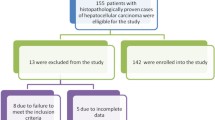Abstract
Introduction
Hepatocellular carcinoma (HCC) is a rare pediatric malignancy that is usually advanced at diagnosis, with a relatively poor prognosis. Extensive treatment, including complete tumor resection, is believed to be necessary for cure. This study was performed to analyze treatment results and to search for prognostic factors of pediatric HCC.
Methods
Between March 1982 and February 2004 a total of 16 children had been diagnosed as having HCC in our institution, and a retrospective analysis was performed.
Results
The median age at diagnosis was 10.5 years, and the male/female ratio was 11:5. As a predisposing condition, hepatitis B virus (HBV) infections were present in 11 (68.8%) and liver cirrhosis in 8 (50.0%). Including 1 patient with a liver transplant, 4 patients (25.0%) underwent a primary operation with complete tumor resection, and 11 (68.8%) received neoadjuvant chemotherapy because of their inoperable state at diagnosis. After neoadjuvant chemotherapy, complete tumor resection was performed in four (36.4%). Thus complete resection was undertaken in a total of eight patients (50.0%). The estimated 5-year survival rate of all patients was 27.3%. The 5-year survival rate for patients who underwent complete tumor resection was 62.5%, and for those who underwent palliative resection or no operation it was 0%. The statistically significant prognostic factors were tumor stage, presence of metastasis, and complete tumor resection.
Conclusions
This study confirmed that complete tumor resection is essential for cure in pediatric patients with HCC, and neoadjuvant chemotherapy improves the tumors’ resectability.



Similar content being viewed by others
References
Stringer MD. Liver tumors. Semin Pediatr Surg 2000;9:196–2082
Reynolds M. Current status of liver tumors in children. Semin Pediatr Surg 2001;10:140–145
Czauderna P, Mackinlay G, Perilongo G, et al. Hepatocellular carcinoma in children: results of the first prospective study of the International Society of Pediatric Oncology group. J Clin Oncol 2002;20:2798–2804
Czauderna P. Adult type vs. childhood hepatocellular carcinoma: are they the same or different lesions? Biology, natural history, prognosis, and treatment. Med Pediatr Oncol 2002;39:519–523
Chen JC, Chen CC, Chen WJ, et al. Hepatocellular carcinoma in children: clinical review and comparison with adult cases. J Pediatr Surg 1998;33:1350–1354
Parkin DM, Stiller CA, Draper GJ, et al. The international incidence of childhood cancer. Int J Cancer 1988;42:511–520
Chen WJ, Lee JC, Hung WT. Primary malignant tumor of liver in infants and children in Taiwan. J Pediatr Surg 1988;3:457–461
Park KD, Seong GW, Lee JK, et al. Results of chemotherapy of hepatoblastoma and hepatocellular carcinoma in children. J Korean Pediatr Soc 1995;38:195–206
Koo HH, Park KD, Jung HL, et al. Carcinomas in children: a 10-year experience in Seoul National University Hospital. Korean J Pediatr 1992;35:1369–1376
Katzenstein HM, Krailo MD, Malogolowkin MH, et al. Hepatocellular carcinoma in children and adolescents: results from the Pediatric Oncology Group and the Children’s Cancer Group intergroup study. J Clin Oncol 2002;20:2789–2797
Brown J, Perilongo G, Shafford E, et al. Pretreatment prognostic factors for children with hepatoblastoma: results from the International Society of Pediatric Oncology (SIOP) study SIOPEL 1. Eur J Cancer 2000;36:1418–25
Jung SE, Kim KH, Kim MY, et al. Clinical characteristics and prognosis of patients with hepatoblastoma. World J Surg 2001;25:126–130
Pimpalwar AP, Sharif K, Ramani P, et al. Strategy for hepatoblastoma management: transplant versus nontransplant surgery. J Pediatr Surg 2002;37:240–245
Ortega JA, Krailo MD, Haas JE, et al. Effective treatment of unresectable or metastatic hepatoblastoma with cisplatin and continuous infusion doxorubicin chemotherapy: a report from the Children’s Cancer Study Group. J Clin Oncol 1991;9:2167–176
Jacquemin E. Progressive familial intrahepatic cholestasis. J Gastroenterol Hepatol 1999;14:594–599
Bruix J, Sherman M, Llovet JM, et al. Clinical management of hepatocellular carcinoma: conclusions of the Barcelona 2000 EASL conference. J Hepatol 2001;35:421–430
Huang K, Lin S. Nationwide vaccination: a success story in Taiwan. Vaccine 2000;18:S35–S38
Katzenstein HM, Krailo MD, Malogolowkin MH, et al. Fibrolamellar hepatocellular carcinoma in children and adolescents. Cancer 2003; 97:2006–2012
Moore SW, Hesseling PB, Wessels G, et al. Hepatocellular carcinoma in children. Pediatr Surg Int 1997;12:266–270
Evans AE, Land VJ, Newton WA, et al. Combination chemotherapy (vincristine, adriamycin, cyclophosphamide, and 5-fluorouracil) in the treatment of children with malignant hepatoma. Cancer 1982;50:821–826
Kim CY, Lee JS, Lee HC, et al. Natural history of hepatocellular carcinoma and survival rate in relation to various treatment modalities—analysis for past 20 years experience. Korean J Intern Med 1993;45:141–153
Superina R, Bilk R. Results of liver transplantation in children with unresectable liver tumors. J Pediatr Surg 1996;31:835–839
Malogolowkin MH, Stanley P, Steele DA, et al. Feasibility and toxicity of chemoembolization for children with liver tumors. J Clin Oncol 2000;18:1279–1284
Curley SA, Izzo F, Delrio P, et al. Radiofrequency ablation of unresectable primary and metastatic hepatic malignancies: results in 123 patients. Ann Surg 1999;230:1–8
Shen DW, Lu YG, Chin KV, et al. Human hepatocellular carcinoma cell lines exhibit multidrug resistance unrelated to MRD1 gene expression. J Cell Sci 1991;98:317–322
Author information
Authors and Affiliations
Corresponding author
Rights and permissions
About this article
Cite this article
Yu, SB., Kim, HY., Eo, H. et al. Clinical Characteristics and Prognosis of Pediatric Hepatocellular Carcinoma. World J. Surg. 30, 43–50 (2006). https://doi.org/10.1007/s00268-005-7965-z
Published:
Issue Date:
DOI: https://doi.org/10.1007/s00268-005-7965-z




